In today’s world, everything is connected through the internet. It’s like a powerful drum that keeps our personal, work, and education lives moving. But when our Wi-Fi is slow, it can feel like sinking in thick mud. The spinning wheel that shows buffering becomes really frustrating.
It takes away the convenience of being instantly connected and tests our patience. Slow Wi-Fi can cause problems like freezing video calls, movies that keep pausing, or files that take forever to upload when we have a deadline. It can annoy us or even disrupt our plans.
The consequences of slow Wi-Fi can go beyond just annoyance. It can affect our productivity, make it harder to learn, and strain relationships when we start blaming each other for using up all the internet. In a world where everything is fast and efficient, slow internet can feel like a chain holding us back, limiting what we can do and stopping progress.
But don’t worry! We’re here to help you understand why Wi-Fi is slow and give you practical solutions to break free from its limitations. Let’s uncover the reasons behind this problem and get you back to fast internet!
Router Placement
Imagine trying to have a conversation across a crowded room – it’s challenging, right? The same principle applies to your router. If it’s tucked away in a distant corner or obstructed by walls, the signal weakens, resulting in slower Wi-Fi.
Solution: Position your router centrally, away from walls and obstructions, to optimize signal strength.
Interference
Electronic devices like microwaves and baby monitors are like chatterboxes, interfering with Wi-Fi signals. Additionally, if your neighbor’s Wi-Fi is on the same channel as yours, it’s like two radio stations clashing!
Solution: Change your Wi-Fi channel and keep routers away from other electronic devices to minimize interference.
Network Congestion: The Digital Traffic Jam
In crowded areas, multiple devices vying for Wi-Fi can create a digital traffic jam, slowing down the connection. It’s like a highway during rush hour! Imagine being in an apartment building, where everyone’s evening Netflix binge leads to Wi-Fi slowdowns.
Solution: By using a Quality of Service (QoS) setting on your router, you can prioritize your device, ensuring smoother streaming. Utilize QoS settings to manage device priority and alleviate congestion.
Outdated Router and Bandwidth Limitations
Older routers may not support the latest Wi-Fi standards, akin to driving an antique car on a modern highway – it just can’t keep up! Additionally, a slow internet plan is like a narrow pipe – it limits the flow of data, capping your Wi-Fi speed regardless of other factors.
Solution: Regularly update your router to a model that supports the latest Wi-Fi standards. Choose an internet plan that meets your data needs and usage patterns.
Device Limitations, Software or Firmware Issues
Using outdated devices is like trying to run a marathon in worn-out shoes – they simply can’t keep up with the pace. Similarly, outdated software or firmware can act like hidden gremlins, causing unexpected performance hiccups.
Solution: Update your devices to newer models capable of handling high-speed connections. Regularly check for and install software and firmware updates to keep your network running smoothly.
Signal Interference
Walls and furniture can act like hurdles on a race track, weakening the Wi-Fi signal. Materials like concrete and metal are particularly challenging, reflecting or blocking signals.
Solution: Use Wi-Fi extenders or mesh networks to overcome physical obstacles and enhance connectivity.
Conclusion
Understanding the reasons behind slow Wi-Fi and implementing these practical solutions can significantly improve your online experience.




